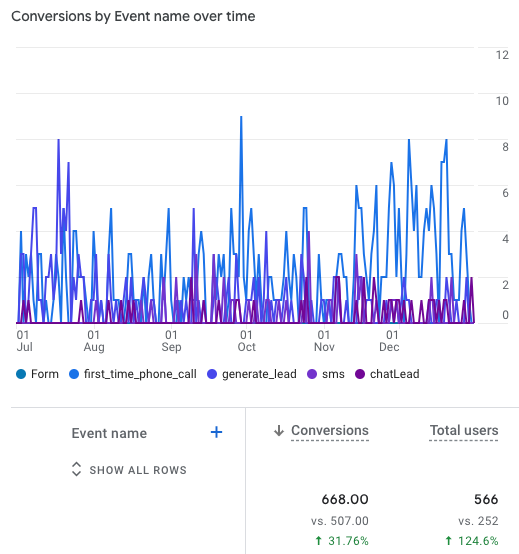In the case studies below, one established law practice increased their total number of clicks from Google searches by 10 times in a 6-month comparison period, with a 32% increase in client conversations including first-time phone calls, chat leads, and email form submissions. Another law firm newly starting their content campaign increased their total number of clicks by 20% and their total impressions by a multitude of 7.
A content strategy based on SEO is like pushing a boulder down a hill. You must put in the greatest effort at the beginning to get things moving. But as the boulder starts moving, it will pick up pace on its own. After a while, you won’t have to do much for it to go faster.
I love my long-term clients because long-term growth is what SEO is all about. The longer we work together, the more I see the fruits of our labor expand and grow. The two case studies below cover two law firms at different points in their content marketing journey – one starting their first year, another stepping into their third year of SEO.
Click here to read about how another one of my clients used SEO content to double their organic visitors and quadruple their conversions. You can also click here to read about how I boosted one website’s organic traffic by 42,375% in just 4 months of blogging.
In a comparison of the first and last 6 months of 2023 for both websites, these case reviews show that great legal content drives steady growth in impressions, clicks, and conversions when planned and carried out with a strong SEO strategy.
Case Study: SEO for Regional Personal Injury Law Firm
I first started working with this small personal injury law firm in 2022 at a rate of two blog posts per month. In 2023, we ramped up our efforts with weekly blog posts. Halfway through the year, I took over the SEO maintenance of their website, which included publishing all of their content. I also combed through their existing content and built a strong web of internal links, categories, and tags for visitors to click further and engage with their website.

What are the key differences in performance between the first and second half of 2023?
- The total number of clicks from Google increased 10x from 1.2k to 12.2k. These are the people who searched for a query and clicked on my client’s page in search results. SEO is all about getting these organic clicks to your website.
- The total number of impressions on Google increased nearly 8 times from 223k to 1.78 million. This is the number of people who saw my client’s pages in Google’s search results. Getting more keyword impressions is the first step to getting more clicks.
- The click-through rate increased from 0.6 to 0.7 percent. This is the average rate of people who click on my client’s links when they see them.
- Although not included in this report, during this period my client’s domain authority rank increased from 18 to 22 from January to December of 2023.
What does all of the above mean for my client? It means that:
- More people are seeing the content that we create, and
- More people who see the content are clicking through to my client’s website. (This also shows that we are targeting the right audience with our keywords.)
- Plus, a higher domain authority means that my client’s website has increased in reputation across the board, which comes with better search rankings as a baseline.
None of the above involved a backlinking campaign. These performance improvements are primarily based on publishing fresh and helpful content on my client’s website and making sure that content gets indexed by search engines like Google. The only backlinking we engaged in was linking to blog posts from my client’s other social media accounts.
This is the first part of a successful SEO content campaign for law firms – getting organic visitors to your website. But what about after these visitors arrive on your page?
A strong SEO content strategy needs clear goals. As a law firm building your online presence and establishing your practice area expertise, you want to do more than just inform. You want clients for your law practice – people to hire and pay you for your services. The second part of a successful SEO campaign involves converting your visitors into client calls.

All of the extra clicks from Google led to a nearly 32% increase in conversions such as chat sessions and email form submissions. More than double the number of users (a 125% increase) converted in the second half of 2023 compared to the first half of the year.
Conversions are critical because SEO campaigns are ultimately about building up your law firm practice – and you need clients to get a return on your marketing investment. The great thing about a good SEO strategy is that any content you publish will continue to pay dividends for you in the long term. Every good piece of content you publish builds on the last.
For example, over the years I’ve written more than 80 blog posts for this client. At this point, whenever I publish a new page for their website, I’m able to include 10+ relevant internal links to other informative pages on their site. Internal links are essential because they prompt your visitors to engage with your content and spend more time on your website. Search engines like Google pay attention to this type of behavior and figure that your website must have something valuable if people are acting this way. Remember: search engines are robots trying to figure out what humans like!
In the last quarter of 2023, I completed a big content cluster of blog posts around two related practice areas with the most promising cases that my client wishes to sign. I’m looking forward to watching how our content strategy plays out, with measurable results for my client.
Case Study: SEO for Local Employment Solo Law Firm
I started working with this client – a solo employee-side attorney – in the second quarter of 2023. They had recently revamped their website but weren’t seeing results with their existing SEO team. They had several blog posts up but none of them were optimized as best as they could be. Plus, the tone of their content was fairly dry and boilerplate, not particularly engaging.
We published between 2-4 blog posts per month over the second half of the year.

Based on our work, my client saw more than a 7x increase in total impressions and more than 20% more clicks in the second half of the year compared to the first. Their website’s domain authority also increased from 1 in January 2023 to 8 in December 2023.
Now, I want to bring your attention to my client’s average click-through rate (CTR) and average position. In this data, the click-through rate has decreased dramatically. In addition, the average position of the website is lower – ranking around position 60 compared to 56 earlier in the year. (Position #1 is what you’re aiming for on Google.)
Although on the surface these numbers look like they’re going in a negative direction, they’re actually evidence of a new SEO campaign working. How is this the case?
Before my client and I started working together, they were ranking higher on search engines mostly for branded keywords. These are searches that involve the actual name of your law firm. Because these searches are so specific, you’re going to rank well for them no matter what. You’re not competing with nearly as many people for branded keywords. Instead, you want to target generic keywords. These are searches that relate to your law firm without mentioning your law firm’s name – for example, the services you provide or the types of cases you handle.
When you start a new SEO campaign, your appearance on search engines begins to shift. Instead of ranking for fewer, branded keywords, you start ranking for generic keywords that get a much higher volume of searches each month. As a result, you naturally start by ranking low for these new keywords. After all, you haven’t established your website’s reputation yet.
Consider the click-through rate. If someone is searching specifically for your law firm’s name, they’re extremely likely to click on your branded website. Meanwhile, as you start ranking for generic keywords with higher search volume and higher competition, your click-through rate is naturally going to be lower in comparison. Once your SEO campaign starts getting traction, these two metrics – your CTR and position – will start to adjust and improve shortly after.
It always helps to have someone who can analyze your website’s performance to handle your SEO and content strategy. Your law firm’s SEO campaign should not feel like a shot in the dark. If you’re considering starting a new content marketing campaign or taking your law firm’s website to the next level, talk to a specialized legal content copywriter who knows their stuff.
My name is Zeynep Goral. I’m a licensed attorney and marketing professional providing SEO and content writing services to law firms. Click here now to schedule your free 15-minute consultation to discuss your law firm’s marketing and business development strategy.
